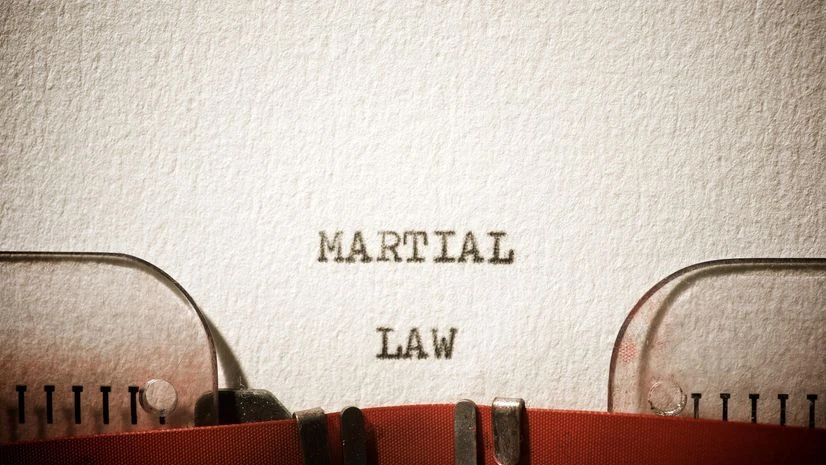South Korean lawmakers on Wednesday demanded President Yook Suk Seol to resign or face impeachment following his controversial declaration of emergency martial law. The move, announced in a surprise televised address late Tuesday night, accused the opposition of engaging in anti-state activities and allegedly sympathising with North Korea. The declaration was reversed within hours, further intensifying the political crisis.
The President’s address marked a dramatic escalation in South Korea’s political turmoil. In accusing opposition parties of paralysing the government, President Yook invoked martial law provisions, which allow the suspension of civilian governance and the imposition of military rule during national emergencies. The abrupt reversal of his decision, however, has drawn criticism from lawmakers, who view the declaration as an abuse of power.
What is martial law?
Martial law replaces civilian governance with military control and suspends civil liberties such as freedom of speech, press, and assembly. Often enacted during times of war, large-scale unrest, or natural disasters, martial law can last for a set period or indefinitely. Under martial law, the military assumes control over civilian legal processes, and executive and judicial powers are often restricted.
Martial law in South Korea
South Korea’s constitution, specifically Article 77, outlines the President’s authority to declare martial law. The provision permits such action in response to armed conflict, war, or similar emergencies threatening public safety and order. It also allows restrictions on civil rights, including freedom of speech and judicial independence, when extraordinary martial law is declared.
Does India have a martial law?
India’s constitution does not explicitly grant the government the authority to declare martial law.
Article 34 merely provides Parliament with the power to legitimise actions taken under martial law and indemnify those responsible. During the British colonial era, martial law was invoked under the Defence of India Acts in 1915 and 1939, most notably in response to the unrest following the Amritsar Massacre in 1919.
More From This Section
However, judicial rulings, including the Supreme Court’s decision in the Puttaswamy vs Union of India case, emphasised the protection of certain fundamental rights, even during emergencies. Unlike South Korea, martial law in India, if enacted, must comply with constitutional safeguards and judicial scrutiny.
Variations of martial law
Martial law and its implementation can vary across the world depending on the circumstances that surround its implementation. Here are some examples on how it can vary:
Full martial law: The military assumes complete control of governance, overriding civil authorities and suspending constitutional rights.
Example: Under Ferdinand Marcos, martial law suspended habeas corpus in the Philippines between 1972-1981.
Partial or regional martial law: This is when martial law is declared only in specific areas rather than the entire country, often to address regional conflicts or security threats.
Example: Martial law was declared in Bangkok in 2014 due to political unrest, with other regions in Thailand remaining under normal governance.
Emergency martial law with civil oversight: Martial law is declared but operates under the oversight of civilian authorities or within a limited legal framework.
Example: Martial law was briefly declared in South Korea last night, but the National Assembly maintained the power to revoke the decree.
Temporary martial law: Martial law is imposed for a very short duration, usually during acute emergencies like natural disasters, terrorist attacks, or significant civil unrest.
Example: Martial law has been used sparingly in the United States, such as during the 1941 attack on Pearl Harbor, to maintain order for a limited period. India’s ‘Emergency’ period in 1975 could fall under this definition.
Provisional martial law: Martial law declared for transitional purposes, often during a regime change or post-conflict reconstruction.
Example: Post-Saddam Hussein, martial law was implemented in Iran in 2004 to stabilise the country during the US-led occupation and transitional government.
Countries currently under martial law
Martial law is a contentious issue globally. In Ukraine, martial law was imposed on 24 February 2022, following Russia’s invasion. The measure has been extended ten times, delaying both the 2023 legislative and 2024 presidential elections, as elections cannot take place during martial law.
Myanmar has been under martial law in numerous regions since a military coup on February 1, 2021, which ousted the democratically elected National League for Democracy. As of early 2023, Myanmar’s military junta has extended martial law to 50 townships across several regions, including Yangon and Mandalay.
Ecuador had declared martial law in January 2024. President Daniel Noboa imposed a 60-day emergency measure to counter escalating gang violence, deploying the military to stabilise the country.
What’s next for South Korea?
The political fallout from President Yook’s actions continues to unfold. Opposition leaders have labelled his declaration a misuse of constitutional powers, while public sentiment grows increasingly critical. Calls for impeachment are gaining momentum, leaving the President in a precarious position. Whether he steps down or faces a formal impeachment process remains to be seen, but his reversal of the martial law declaration has significantly weakened his political standing.
As South Korea grapples with this crisis, the global conversation around the use of martial law remains as divisive as ever.

)